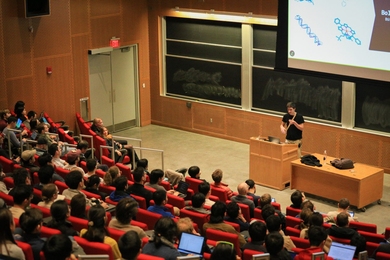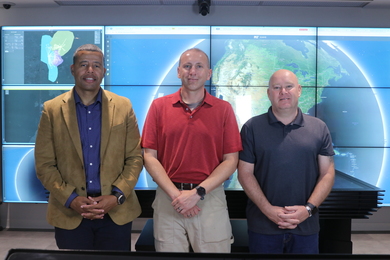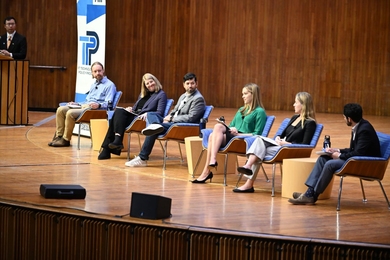MIT's reputation for cutting-edge technology isn't always matched by the audio-visual equipment available in Institute classrooms, but a trio of new, high-tech classrooms which are part of the Center for Advanced Educational Services (CAES) and the Teaching and Learning Laboratory may help tilt the balance.
The Building 9 classrooms, collectively referred to as the Teaching and Learning Triad, were dedicated Monday in a ceremony hosted by Chancellor Lawrence Bacow and featuring a virtual presentation by Diana Laurillard, pro-vice chancellor and professor of educational technology at the Open University in the UK, who made her presentation and engaged in an interactive panel discussion from a video conferencing facility in England.
On the MIT campus, that portion of the dedication ceremonies took place in the Learning Networks Central or LiNC (Rm 9-057), and was broadcast live to an overflow audience seated in the other two new rooms: the Stephen P. Kaufman (1963) Family Classroom for Instruction in Teaching (Rm 9-151) and the Ford Virtual Design Studio (Rm 9-152).
"With this triad, we have leapfrogged into having the best learning and technology center for higher education in New England," said Professor Richard Larson, director of CAES, the group that will manage day-to-day operations in the new classroom/studios.
"The project has been a collaboration of three separate interests working under a single umbrella," said Dr. Lori Breslow, director of the Teaching and Learning Laboratory, which will provide the administrative home for the Kaufman classroom. "While each of the classrooms is designed for a particular function, they're linked together in a way that gives them multifunctionality."
THE CLASSROOMS
LiNC is a 45-seat tiered amphitheater used for CAES-sponsored programs. The space is equipped for integrated on-campus and off-campus teaching, corporate training and goal-oriented learning. Networked-data and power ports are available at each student's desk area. Remote controlled cameras, multiple monitors, screens and chalkboards, and gated microphones are centrally routed from a dedicated control room.
MIT's first virtual degree program, the Systems Design and Management program, as well as CAES's continuing education and distance learning programs will broadcast from the LiNC using a wide variety of technologies. Priority will be given for faculty members who are using technology for instruction on campus and for students at a distance.
The Kaufman classroom will be used primarily as a training studio for faculty and teaching assistants to improve their teaching techniques. It's equipped with three video cameras, six microphones and a separate editing studio, which allow the dynamics of the classroom to be captured on videotape in the most realistic way possible.
The classroom can accommodate up to 28 students and is available for use by MIT faculty, teaching assistants and instructors who want to improve their pedagogy by taping their lectures and reviewing the tapes afterwards with a professional teaching consultant. Electrical engineering and computer science alumnus Stephen P. Kaufman (SB 1963), chairman and CEO of Arrow Electronics, launched this teaching instruction project with a major gift.
The Ford Virtual Design Studio is a versatile collaborative laboratory that is conducive to goal-oriented learning primarily in the area of engineering design. The studio, designed as a flexible and reconfigurable space, is a highly networked, computer-intensive space with unistrut grid lighting, equipped with room and desktop videoconferencing technologies.
The Ford studio will be administered by CAES and used to support the projects in environmental research, virtual engineering and virtual education that are part of the Ford/MIT Collaboration, a multimillion-dollar partnership focusing on education and research, with special emphasis on environmental challenges. The new studio will also be used by other programs at MIT associated with Ford. Professor John Williams of civil and environmental engineering, director of the Intelligent Engineering Systems Laboratory, will serve as the MIT coordinator for the studio.
The classroom triad was built in space formerly occupied by the 35-year-old lecture hall in Rm 9-150. The new rooms actually added 1,700 square feet of space to the campus by placing a second level in what had been air space above the old, steep-pitched auditorium. The lower level is now the 980-square-foot amphitheater called LiNC; the upper level houses the Kaufman classroom and the Ford studio. The architectural firm of Einhorn, Yaffe, Prescott designed the space, and Payton Construction served as the general contractor.
The design was based on recommendations for space enhancement made by former Provost Joel Moses's Council on Educational Technology, co-chaired by Professor William Mitchell, dean of the School of Architecture and Planning, and Professor Michael Dertouzos, head of the Laboratory for Computer Science. Funds for the project were provided by the Office of the Provost, the Ford/MIT Collaboration and the Kaufman family.
A version of this article appeared in MIT Tech Talk on September 30, 1998.





